Shea R. Oliver's Blog, page 8
October 8, 2018
Where’s My Battle Unicorn?
Take yourself back a few thousand years and image that you’re marching into battle with your fellow foot soldiers. You feel confident as you grip your sharp spear and feel the weight of your shield.
The enemy forces are heading in your direction. A broad plain opens to reveal your vile adversary lined up and moving toward your ranks. Adrenalin begins pumping through your veins as you grid yourself for the coming confrontation with their front line.
Suddenly, the enemy’s front line re-forms to allow a torrent of beast-mounted soldiers to come crashing through. A multitude of fast-moving, angry monsters comes charging toward your line, snorting violently while their riders urge them forward in frenzy of bloodlust.
You stare directly at these monstrous creatures charging toward you and realize that not only can they trample and crush you, they can also skewer you with their horns!
A voice inside you screams “You’re screwed!”
I mean, seriously, haven’t you ever wondered why we’ve never seen armor-adorned rhinos with riders? I’ve seen plenty of make-believe images of people riding imaginary unicorns, but what about a real-life, seriously scary beast with horns? We ride horses, elephants, and even ostriches.
So, I did a little research and found all kinds of interesting “reasons” why we don’t have domesticated or even tamed rhinos. They are ill-tempered, near-sighted, difficult to get near, and a few other seemingly valid reasons.
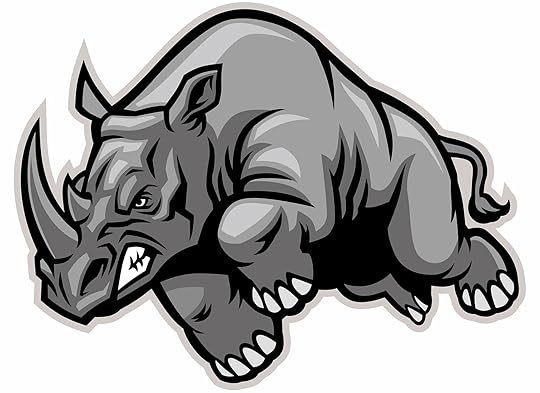
In others words, it’s just too hard. Many of the people that I’ve talked to through the years who want to do something different with their lives have the same problem. It’s just too hard to do. I mostly get it, until I look at a chihuahua.

Change Takes Time, Effort, Patience and Persistence
Someplace a very, very long time ago, someone looked at a wolf, or perhaps an ancestor of a wolf, and thought, “wouldn’t that make a wonderful pet for my kids?” Okay, they might not have considered that, but someplace, somehow, some group of people decided that having those pack-hunting, sharp-toothed, downright-scary creatures as companions might be a pretty cool idea. Naturally, it didn’t happen overnight, but look at the remarkable results!

The same is true for changing your life. While there may be some behavioral changes that can be implemented overnight, most real change takes significantly more effort. Whether you are considering skipping the corporate life for wandering the Kalahari or simply making a significant career change, transitioning yourself from who you are today to something else is a process. It’s going to take time, effort, patience, and persistence.
There’s Even A Big Bonus!
While many people who dream about changing their life focus on what it would be like to do something else, something more spectacular often happens. It changes who you are, not just what you do.
Similar to the desire to have those wolf ancestors around the homestead, the end result can be wildly different from what the original idea was all about.

The post Where’s My Battle Unicorn? appeared first on Shea Oliver.
October 1, 2018
Drew Carey and The Zombie Apocalypse
I’ve got some bad news for you. The zombie apocalypse has already begun. I know that you were planning on stockpiling food and weapons, but it’s too late. It’s been going on for quite some time, all around you. Are you telling me that you didn’t notice? It’s been going on for decades.
Do you remember The Drew Carey Show? It was a sitcom that revolved around the everyday life of its loveable, ordinary, lead character, Drew Carey. He went to work in a typical office. He went home to his plain American house. He had some good people in his life and had some annoying people in his life. Occasionally he had an adventure, but mostly he just lived his life, day-to-day.
In one of the episodes, another one of the characters wants to quit her job and proclaims that she “hates her job.” Drew Carey replies:
“Oh, you hate your job? Why didn’t you say so? There’s a support group for that. It’s called everybody, and they meet at the bar.”
While comical, the message is simple. It doesn’t matter whether you are happy or miserable. You have to keep your job. You have to live this ordinary, average, traditional, conventional life. If you’re unhappy, then turn to external solutions such as alcohol or drugs to soothe the pain inside. In short, you have to become a zombie, like everyone around you.
Real Zombies Eat More Than Brains
You’ve probably got this Hollywood-created version of zombies in your head. They’re the reanimated dead, with practically no cognitive capability except that which furthers their one goal – eating your brains.
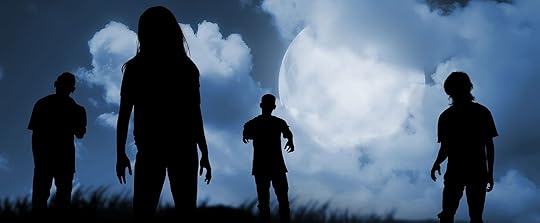
Real-life zombies are much more frightening. They eat more than just your brains. They devour your soul, consume your true desires, and gorge themselves on any inkling of non-conformist thought or behavior. And they are far more insidious than the zombies on the screen.
You can run from the fictional zombies. It’s clear who they are, and there is no illusion that they mean to eat your brains. The real-life zombie horde wants more than just your brains. They want to make you one of them. They smile and have your best interest at heart. Making sure that you are “safe” and don’t do anything impulsive or risky is essential to them.
The zombie horde may already be all around you, and you might not even know it. It’s the narrative that you believe. It moves through the dark recesses of your brain, occasionally surfacing to keep you in line. It was the questions that you were asked as a child. It was advice that you received as a teenager and young adult. It was conversations that reinforced how life should be lived.
“What do you want to be when you grow up?”
“Come on, be realistic.”
“It’s time to stop daydreaming and be responsible.”
“Well, that’s not a realistic goal or way to make a living.”
The messaging leaves a nearly indelible mark on your consciousness. The messaging is clear and echoes over and over through your mind.
If you want to be “successful,”
if you want to be a “good person,”
if you want to be “respected,”
Then you must march to the drumbeat of ordinary. Bring your actions, decisions, thoughts, and values into alignment with the regular people. Don’t stray from the path.
Time To Hunt Some Zombies
Ultimately, many people are comfortable being part of the zombie horde, and there’s nothing wrong with wanting to live a traditional, normal, in-the-box life. However, for many, many people, the constraints are emotionally crushing, but they feel trapped and unable to move against the norm.
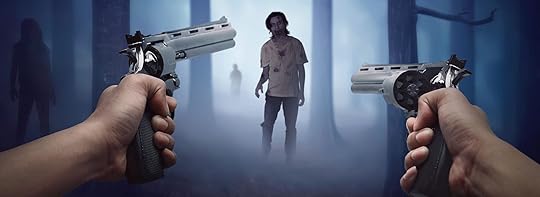
Hunting zombies may sound like a satisfying activity, especially if I was here to share with you tips or tricks for getting at all those people in your life that are making you feel trapped. But I’m afraid there’s more bad news for you.
The zombie horde isn’t out there in the world. It isn’t the people around you that are “making” you live a miserable existence trapped in an ordinary, unfulfilling life. The monsters that you are fighting are in your head.
Yes, we may live in a society that has certain norms, practices, and expectations. All the people around you may be actively encouraging you to get on the same bus that they are traveling on, but the choice is yours. I can already hear your excuses. It doesn’t matter what they are; those excuses are also part of the zombie culture. They are you allowing yourself to be consumed and integrated into a standardized life.
The first step in radically changing your life is a decision. It is a decision to change. It is a decision to do something different. The decision will very likely mean that you’ll have to “gear up” and kill some zombies – the frighteningly dangerous ones that live inside your head.
The post Drew Carey and The Zombie Apocalypse appeared first on Shea Oliver.
September 24, 2018
Changing Your Life is Like Carrying a Snapping Turtle
I know that many people will be looking at The Priority Paradigm and making a HUGE assumption about the people that I am interviewing. “Changing your life” for many people means a sudden, dramatic, earth-shattering shift. It happens immediately and undoubtedly alters everything, including what a person knows and who they are.
While there might be an example of that here and there, the majority of people who make a radical change in life don’t do it overnight. They consider and plan their shift. They assimilate what they know and work to learn more. Sometimes, a false start needs to happen to clarify direction and concepts. Then they execute.
A chance encounter with a snapping turtle reminded me of exactly how that works.
The poor reptile was attempting to cross a road at the edge of town. I pulled over, as I always do for at-risk wildlife on the road. I’ve done that ever since I learned to drive, and made others pull over when I am a passenger. Usually, I’ll carry box turtles or shoo snakes off the road to make sure that they don’t get run over. However, I’ve never handled a snapping turtle. If you don’t know, they are rather ill-tempered animals. If they bite you, either you lose a finger, or they just don’t let go. I stepped out of my Jeep, not sure how to handle the situation, but only knowing that I didn’t want to see the turtle getting squashed.
Committing and Pressing Forward with the Decision
I realized that I wanted to do something that I’d never done, but I didn’t just run out of the car and grab the turtle. I began directing traffic around him so that I could think and plan. My mind spun through my experiences handling other tortoises, turtles, and other wildlife. Whenever possible, you should avoid handling wildlife. It’s stressful for them and dangerous to you. Sadly, this poor creature was stressed and not moving, so I couldn’t just guide him off of the road.
Without time to get onto YouTube to figure out the best way to assist the creature and not wanting to direct traffic around him all day, I decided to try to help it the same way that I’d helped other turtles. I’d pick it up and move it by grabbing his shell in the middle on each side between its legs. A dangerous decision, as they have long necks and sharp claws. My first attempt only got him a few feet as he was slimy on the bottom, heavier than I thought, and his claws hit my fingers as he panicked. I dropped him a couple of inches and felt terrible, but probably not as bad as he did.
When I realized that he hadn’t even broken the skin on my fingers, I picked him up again. He struggled and hissed, but I was able to carry him across the road quickly and put him down in some tall grass by the ditch that he was heading toward initially.
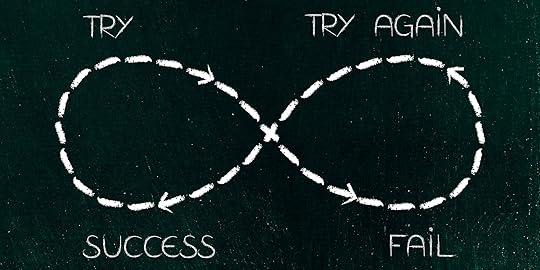
Massive radical changes in life often work the same way – contemplating, planning, attempting, failing, attempting again, and succeeding.
Life and Projects Have Constant Tweaks
Often when we move forward in life or with a project, we feel as if we have to keep going in the same direction. We get trapped in the thinking that if we did it this way before, we better keep doing it that way. If that direction is working, then it’s not a bad idea to power forward. But there’s nothing wrong with making some modifications even when things are working.
I’m making another little tweak to this project. I’m uncoupling the uploading and sharing of the actual interviews, the transcript, and the story of the amazing person. I want to make sure to get the conversations posted in a timely manner, and completing the other two items can be done more deliberately.
Thanks again for your awesome support of this project. You totally rock!!!
Cheers!
Shea
The post Changing Your Life is Like Carrying a Snapping Turtle appeared first on Shea Oliver.
September 17, 2018
My Adventure to Discover El Dorado
I started The Priority Paradigm project on a mission to build a greater understanding of people who’ve made radical changes in their lives for something more important. Like anyone who starts any experiment, I had some hypotheses. Guess what I learned?
I’ve been reading about, watching programs on, and studying people like the ones that I’m interviewing for years. They fascinate me. Of course, I’ve read lots of books in the genre of “changing your life,” and “following your dreams.”
However, I’ve always wondered if there was a variance from the “exterior narrative” that is told in so many places, to what is really, really happening inside the minds and hearts of these larger-than-life, unusual folks.
Listening, Pondering, and Truths about Bullshit
Within moments of diving into this project, some clear patterns began emerging. Some of my initial thoughts and assumptions were quickly validated. Some of my thinking continues being tweaked to a more accurate representation.
And of course, like a smack in the head, a few of my hypotheses were wrong. Dead Wrong. And, I’m a little embarrassed about my current state of enlightenment.

If you’ve ever watched my intro video, you’ll hear me say “people just like you and I.” (yes, grammatically that should have been “me,” but after like 600 tries at getting it in one take, you know…).
It’s NOT the radical differences in thinking or emotional state that I am facepalming over. It is that some of my hypotheses were built on a big, stinking pile of bullshit. I’m talking about the self-help, self-improvement, self-development racket that I’m diving into like a 7-year old at a pool party.
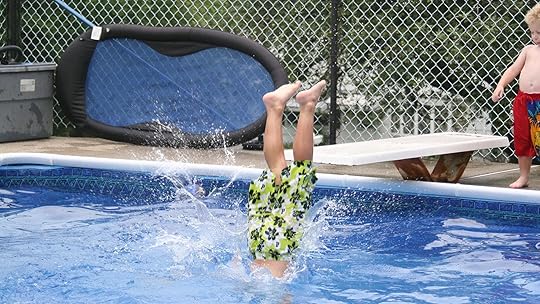
So, I’m letting you in on a little, open secret. These amazing people, well, they are just like you and me (said Shea using correct grammar for a change). They make these massive, radical changes in their own lives by focusing their minds and thoughts in a slightly different way, and those little variations in focus enable them to do the seemingly impossible.
As much as I was hoping for a Moses-coming-down-from-the-mountain moment with heavenly rays of sunshine illuminating me while I pontificate upon my grand discovery, it ain’t happening folks. I’m not going to find the Holy Grail, the Lost City of Gold, or the Fountain of Youth. Nor am I going to find the Magical Tablets of Radical Change.
The 7 Mindset Secrets for Radically Changing Your Life
Like a writhing glob of primordial ooze, my notes, musings, and highlights are morphing into bullet points and supporting evidence. Words and phrases are emerging from the muck, forming into a structure, battling their way into an architecture of logical configuration.
Maybe a little literary license there? Okay, I’m working on the outline for the book. If you’re paying attention, you’ve already figured out my working title. Over the next couple of weeks, I’ll be sharing more, including what the 7 Mindset Secrets are. I’m still polishing the initial phraseology and short explanation of each point.
The post My Adventure to Discover El Dorado appeared first on Shea Oliver.
May 8, 2018
NuCamp T@G XL Outback Walkthrough
For the last few years, I’ve been watching the popularity of teardrop trailers explode. These tiny camping wonders were popular in the 1950’s and over the last decade, they’ve made a tremendous comeback. I’ve joined the growing number of folks who are upgrading from tent to a bit more luxury. Here’s a quick video that I put together after picking up my 2018 NüCamp T@G XL Outback.
In the coming weeks, I’m traveling to a number of destinations around Colorado, Utah, and Wyoming. I’ll be posting more videos while having some time in the wild to work on writing more of my 1001 Tales of Treasure.
The post NuCamp T@G XL Outback Walkthrough appeared first on Shea Oliver.
March 1, 2018
Beginning 1001 Tales of Treasure
Refining your dreams and goals can bring both focus and clarity. In the summer of 2017, I launched “My National Park Quest.” It was born during a trip to some of the astounding National and State Parks in Utah. The goal of my quest was to visit every National Park Unit, along with every National Monument, Forest, and Grassland.
An Unease Settles In
Over the next few months, I began checking off a few of the locations on that enormous list. It was exciting and invigorating to start the monumental task, but something didn’t sit right. Perhaps it was the list and checkmark concept. There was a feeling of confinement, narrowness, and hurry.
The truth is that fascinating, meaningful, and remarkable places exist outside of my predetermined checklist. I planned to share stories of the destinations on my blog but found myself looking at photos from locations not “officially” on my list and telling myself that those places don’t count.
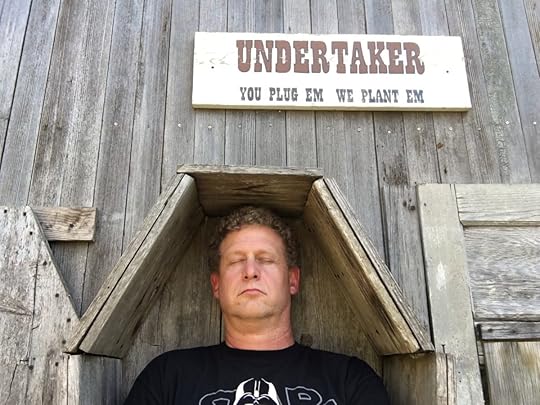
If that wasn’t enough to make me ponder, I’d write one blog post about a location, and then get stuck debating whether to write another about the same location, aka “item on the checklist.” I found myself mentally plugged up, wondering if I should even bother to write the stories of my travels or just put the checkmark down and count it as done.
Additionally, the way that I had defined the quest was too geographically constrained. Part of my quest was born out of the knowledge that I would be an empty nester in a few short years. I am planning to transition to a nomadic lifestyle, but I know that it will include more than just the United States. I have always dreamed of sailing around the world and using the sailboat as a base to travel inland.
It became clear to me that I needed to redefine this quest as something very different. I began thinking about expanding the list, after all, there are over 3,000 National Parks on planet earth, but that wasn’t quite the ticket.
Redefinition and Relief
In a moment of contemplation, I realized that what I honestly wanted to do was to travel to beautiful and meaningful destinations and
share my experience, photos, videos, and stories
The point was more than the checkmark on a list. It was the journey and the telling of the story, along with sharing the pictures and videos. Redefining my quest opens up a world of possibilities.
I am still planning to visit all of the US National Parks, Monuments, Forests, and Grasslands as part of this mission. However, the definition of where I am going will be much broader with a focus on sharing the adventure with you. I won’t be rushing place to place in order to check it off the list.
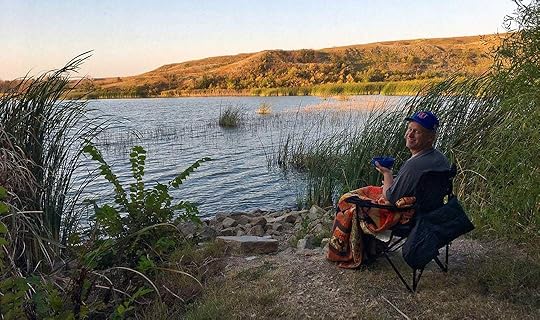
I’ll be enjoying the moments and capturing the wonder and sensations that spring from an unending curiosity and desire to see the beauty of the natural world and reverent contemplation of visiting sites of significant historical value.
Transitioning to 1001 Tales of Treasure
Coming up with a unique way to encapsulate the redefinition took a bit of thinking. I considered calling it My National Treasures Quest or Stories From A Traveler. The idea that places that I am visiting are treasures stuck. While we might think of treasures in terms of gold and jewels, these treasures are something so much more.
The destinations are treasures in terms of the locations themselves. However, regardless of whether national, regional, state or local entities have blessed the geographic area, my quest seeks places of real human value.
The destinations that I seek are treasures for those who visit. They provide moments of personal contemplation, a connection with nature, and a timeless kinship to the people who made the location valuable.
I am more excited than ever to dive into this new quest. While I love my moments alone in isolated places of nature, I feel even more connected to the world at large when my stories are shared and enjoyed by others.
So, today, I begin my telling of…
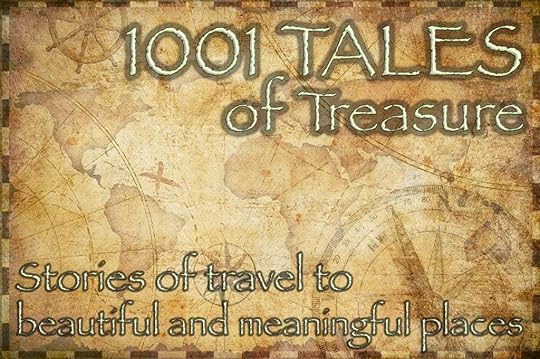
The post Beginning 1001 Tales of Treasure appeared first on Shea Oliver.
February 20, 2018
Relaunching Your Life for Authentic Happiness
When you were a small child, you told those around you about your dreams. Praise was heaped upon you as you expressed your longings for things that felt meaningful and important to you. You were encouraged to use your imagination and promised that nothing was out of your reach. The life that you imagined for yourself contained no end of adventure, happiness, purpose, and excitement.
Then one day it all changed.
Your dreams began gathering dust
Realistic is often the word of choice. Reasonable, pragmatic, or prudent work as well. Whether we did it by grand plan or whether it happened inch-by-inch without our conscious realization, we end up in the same place: “NORMAL.”
For many people, that existence of ordinary is okay. It feels safe and protected. Anything else would be far too risky. They wouldn’t have it any other way, and there’s nothing wrong with their decision.
The rest of us want something more, but we have so many questions.
Where does the courage come from to leave “normal” behind?
What happens when the cubicle walls begin to feel like prison bars?
Is it really possible to leave behind that 9-to-5 job?
How does your life change when you chase your dreams?
Can you make a go of it, without sacrificing everything?
How do you prepare to make that radical change?
Is there authentic happiness out there somewhere?
I’m on a mission to answer these questions and many more, while discovering and sharing the stories that motivate and inspire us on our own journeys.
The Priority Paradigm
I’m launching a new project to explore what motivates people to make radical changes in their lives and veer from the “normal” model of life.
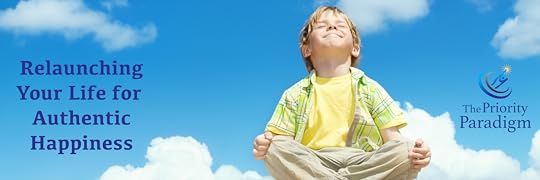
This project starts with video-tapped conversations, lots of them! I’ll be talking with folks who have made radical changes and relaunched their lives. You’ll be able to watch these conversations on social media and on the website.
Once, enough of these conversational interviews are conducted, I’ll write a book based on the stories, knowledge, insights, and wisdom of these real-life heroes.
The original concept for this project started long ago, but I kept waiting for the “right time.” Then I realized that perhaps I was the one trapped in “normal.” I had a plan for what The Priority Paradigm would be… and it followed what would be a “normal” course for an entrepreneur like me. So, I’ve thrown caution and comfort to the wind and am heading down a radically different path than I originally planned.
Our world is filled with fascinating people who have escaped “normal.” They chase their dreams and pursue fulfillment and happiness in ways that we admire. I want to learn why and how they did what they did, and I want to share their stories.
I Need Your Help! Who Do You Know?
Are you someone who has made a radical change in your life and veered away from the “normal” model of life?
We want to hear your story!
Who do you know that fits this profile?
They don’t have to be famous or well known. I’m looking for people who experienced a shift in what they thought was important, or finally acted on what they believe to be important, and headed in another direction in life.
Please drop me a note on my Contact Form.
Website and Social Media
The digital foundation for the project is in place. Please follow the project on social media and check out the website at ThePriorityParadigm.com.
Facebook: https://www.facebook.com/ThePriorityParadigm/
YouTube: https://www.youtube.com/channel/UCLcOorKHcZBDL56_gkmenjg
Twitter: https://twitter.com/ThePositiveBeat
Instagram: https://www.instagram.com/ThePriorityParadigm/
The post Relaunching Your Life for Authentic Happiness appeared first on Shea Oliver.
September 8, 2017
Descending into the Black Canyon of the Gunnison
As the sun began to stretch across the sky, I finalized my preparations for the day. One goal dominated my thoughts: enjoy the challenge. Reaching the Gunnison River from within the Black Canyon of the Gunnison National Park presents two broad options, either a technical climb down 2,000-foot cliffs or a “hike” down one of the draws or ravines.
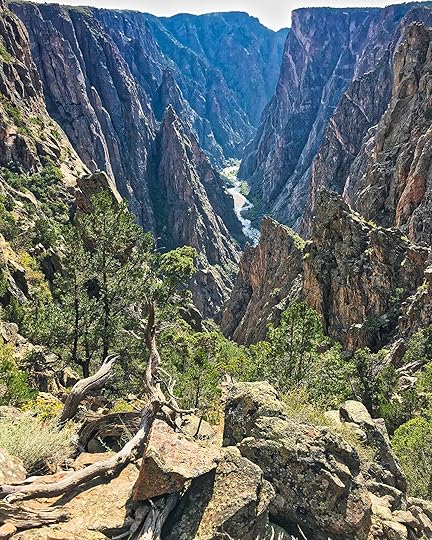
The evening before, the search and rescue ranger looked me over and asked a few questions before answering my inquiry, “Which is the easiest non-technical route to the river?” His measured look stemmed from experience. What was the probability that I would require rescue?
Sometimes a name means nothing. Other times, something like “SOB Draw” earns its name. I would expand the acronym more than once as I climbed out the next day.
Off to a Great Start
As the sun finished rising, I slipped one copy of my wilderness permit into the ranger station’s bin, tucked the second copy in my backpack, and wrote my name on the board.
No one enters the inner canyon without a permit. The second copy is returned to the ranger station to inform the rangers that you made it out. NPS Search and Rescue Rangers are serious bad asses. They accomplish amazing feats in saving lives, and there is a comfort knowing that they are protecting both the park and its visitors.
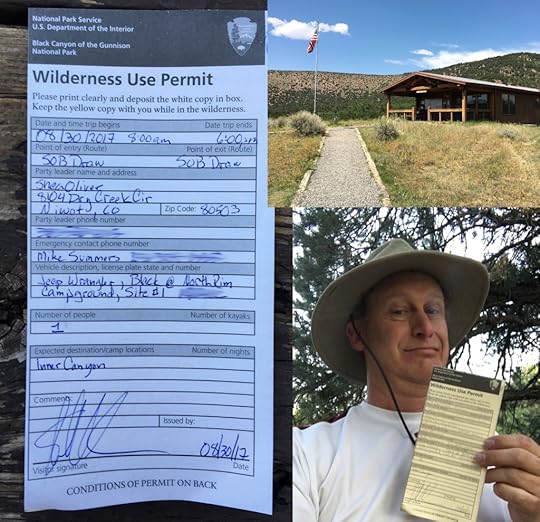
The first mile or so of the SOB Draw is a gentle slope through sage brush and piñon-juniper woodland. It’s easy hiking down a “social trail,” as the Park Service does not maintain any official trails into the inner canyon.
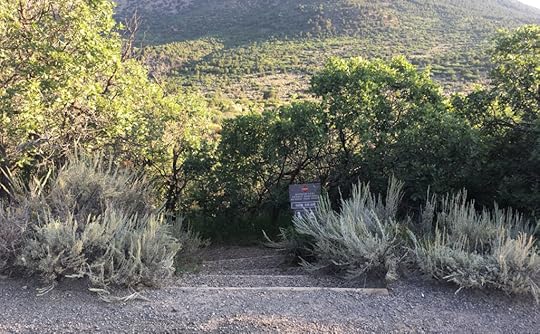
Once the views of the canyon open up, the challenge of this “hike” became apparent. The gentle descent becomes a harsh decline. Loose gravel, scrambling cairn to cairn, and poison ivy replace the well-worn trail, sage brush, and pine.
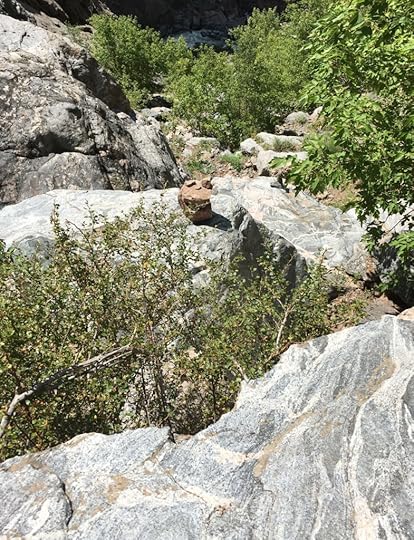
After a tedious hour of moving down the draw, I sat down to rest and absorb the stunning magnificence of the canyon. Staring at the walls of the canyon, I thought I saw a bird.
The sheer scale of the Black Canyon is hard to capture. The photo below points out what I saw. Can you tell what it is?
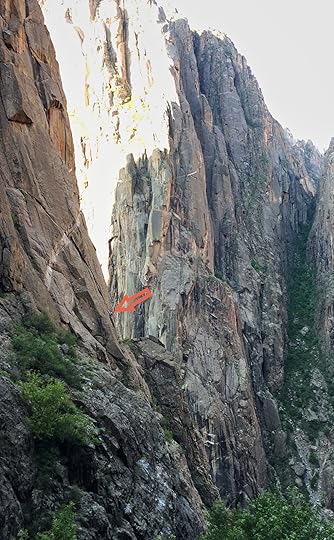
As I decided not to take my DSLR, I was snapping pics with my iPhone. I wish I could have zoomed in on the “bird” which was in actuality a man. He and his crew of two other climbers had quite a long ways to go!
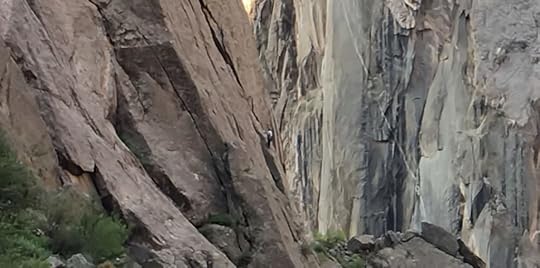
For the next hour, I occasionally thought about throwing in the towel. Trekking down the slope was arduous and exhausting. Plus, I knew that in a few hours that I would have to reverse course. However, even in those moments, I would take a deep breath and realize how much I genuinely was enjoying this challenge. Not another soul was anywhere nearby. I was immersed in nature and could feel my spirit moving toward a more balanced and restful state.
Reaching the River
When I reached the bottom of the canyon, I picked my way through the boulders along the river until I found a comfortable one, perched out into the water. After a few pictures and the video below, I laid back in an indentation in the rock, closed my eyes, and enjoyed the sounds of the river crashing toward me and rushing into the distance.
With walls stretching almost straight up 2,000 feet, the canyon has areas that get little sunlight. As I was preparing to explore, the sunlight burst onto my boulder. The sudden change from dark to light startled me, but all of a sudden the light began to dance through the cascades, revealing even more of this dark chasm’s personality.
I wandered my way down the river, looking for a campsite that I had seen from higher up. Being in the canyon is a unique experience. At once it is both exhilarating to be so isolated and contained, but at the same time slightly foreboding. You can feel the raw, unbridled power of mother nature in places like this.
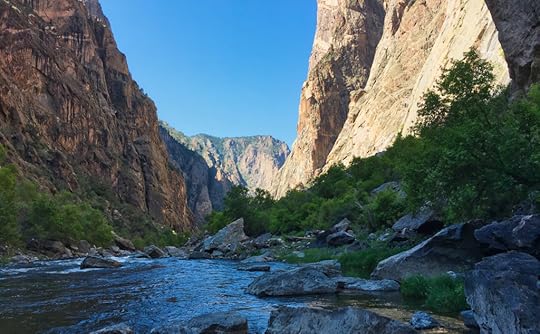
At the campsite, I met Ed, the other name on the board at the ranger station. He and his son, along with a friend, had spent the night in the canyon. The river was offering up some of its famously large trout to the group, and they seemed to be having an excellent time. After a pleasant chat with these fellow adventurers, I headed back to begin my trek out.
Noticing Small Details on the Way Up
As expected, the journey up was far more taxing than the trip down. A gentle rain began to fall as I reached the halfway point, slowing me further. Many times, I simply stopped and sat down, needing to rest, but also not wanting to leave. I wanted more time to absorb the positive vibes that seem to radiate all around. The truth is that I love being alone in the wild. I feel at home. If I let it, a calmness spreads through my being, making all the hustle and bustle of modern life melt away.
At one point, I sat down on a low rock. Looking over at one of my hands, I realized that in the space of less than a square foot, there were many different types of rocks. I’m no expert, but it was interesting to see so much variation so close together.
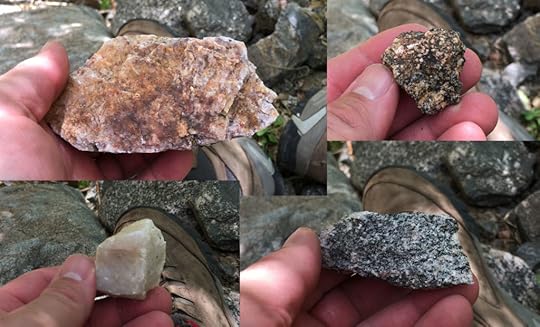
As I was checking out the colors and textures of the rocks, something caught my eye. It’s unusual for me to come across snails while I am hiking, but only a few feet away there it was!
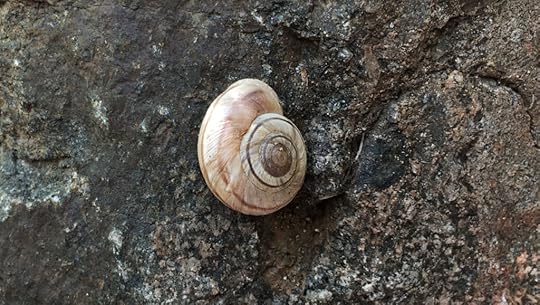
I snapped the picture, and when I returned, I posted the picture to a Facebook page called Colorado Snails. They informed me that it was an oreohelix, which is native to that part of the state. I’m sure that I’ll be more conscious of these little creatures, and I hope to find more.
As I neared the top of the draw, satisfaction began to spread throughout my being. I’d done it. Alone. Deep within me, something draws me to these remote places. I love every moment in isolation in the wilderness. It’s something primal that calls to me. And I’ll answer the call again soon.
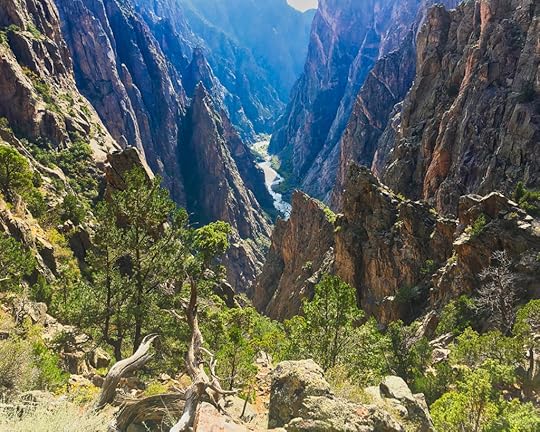
BE A HERO & SHARE THIS PAGE
Share List
LEAVE A COMMENT
Please don’t be shy! Let me know what you think!
SUPPORT CRITICAL CONSERVATION EFFORTS
The post Descending into the Black Canyon of the Gunnison appeared first on Shea Oliver.
August 26, 2017
I’m Not A Racist, But…
When I was a young adult in the 1990’s, I had a conversation with an older relative. She lived through the Dust Bowl, the second World War, the Civil Rights Movement, and all the other events of the 20th Century. I’d never heard her say a disparaging word about another race, and she certainly would never identify herself as a racist. However, one day she said:
I don’t have a problem with black people, I just don’t know why they want to move out of their neighborhoods.
While there was no intended malice, the statement reveals a prejudice, a mindset, a belief system, or whatever you want to call it. Growing up in the post Civil Rights era, it struck me hard. How could she actually believe, much less say, something like that? I absolutely didn’t agree with her. I’m not a racist, but…
The Blindness That We Become
The experiences that we have, from our family to our friends to our education to just life happening, shape who we are. Because we are limited creatures, living moment to moment, we can only absorb and process a limited amount of data. It’s part of what makes us each unique, but it also can make us blind.
We are social creatures. We tend to associate and collect ourselves in groups that have some commonalities. Whether it’s geography, race, religion, nationality, interests, or whatever, our innate drive is to connect with other human beings, and it is far easier to associate with those whom we perceive as similar to ourselves.
Our social drive only tends to amplify the individual experience that we are having, and that is that “others” are different than us. We each experience this individually when we look at every other person around us. Combine that with the comfort of belonging to a group, and when we look out into the world, everyone not in our group looks even more foreign.
Confronting the “Other” in a Mexican Bar
When I was 18, I was a chaperone on a mission trip to Mexico. Our accommodations were a dormitory outside of a large city. One evening, another chaperone and I decided that since we were in Mexico, where the drinking laws were different, we would slip out for some adult activities.
We headed to the bar that was about a mile away, on a dark, isolated, country road. As we weren’t old enough to drive the rental cars, we walked. I had no idea when I stepped into the establishment, that I was about to get a lesson regarding my own bias and on being human.
About twenty men sat scattered around the open-air building. It wasn’t a movie scene, but it quickly began to feel like one. Trying to appear more mature and experienced than we actually were, we headed straight toward the bar. Within a few paces, the silence and stares from the patrons were overwhelming. The bartender intently watched us as we sat down. The words came out of his mouth deliberately
You can’t be in here. You don’t belong.
At that moment, fear washed over me. We’d shown up someplace that we didn’t belong. The silence of the room was deafening. We were in serious trouble, in another country, surrounded by what suddenly looked like some very “bad hombres.”
A Racist Reaction?
We’ve all had those moments. Our mind kicks into automatic. The thoughts that flow tend to come from someplace deep within us. Whether it was from personal experience or stories or media or whatever, our survival instincts kick in.
Everyone in that building had instantaneously become part of that nebulous concept of “other.” They weren’t like me. Their skin was different. They spoke a different language and were a different nationality.
In my mind, whether I knew it or not, I perceived that they saw me as an “other.” My caucasian, American friend and I were something outside of who they were. Even as we sat motionlessly, my instincts were furiously working to figure what to do in this completely new-to-me situation.
The Moment of Truth
“You can’t be here. You don’t belong.” In the brief moment, before the next words came out of his mouth, my thoughts had traversed all these terrible scenarios. Because the situation was outside of my experience, my mind instantaneously generated potentially negative outcomes. Whether that came from watching old westerns, the community in which I grew up, or was simply a primal survival reaction, it happens. I am human.
“This is a members-only bar, and you’re not members.”
Boom! All of the mental pictures that I had drawn instantly disappeared. But, I was right. I was an “other.” But the categorizations that I dreamed up were wrong. I just wasn’t a dues-paying, card-carrying member of this establishment. It wasn’t the color of my skin. It wasn’t that I was American or spoke a different language. Those things were obvious, but they weren’t important as to why I didn’t belong.
Since you’re from out of town, you can stay and have one beer, but then I’ll have to ask you to leave.
The next half hour was pleasant as we chatted with a few of the other members of the club. They were interested in hearing about where we came from, our mission work, and then they wished us well as we headed back to the dormitory.
The Lesson of Being Human
The reality that we create in our mind is often completely out of sync with the realities of others around us. Skin color, language, and nationality were part of the visible differences between us and everyone else in that bar. As humans, when we gaze out into the world around us, we have this innate need to clump people together by their commonalities. Skin color is one of those easy-to-use groupings.
Had I walked into an all-white, Norwegian, biker bar, and had an identical encounter, no one would say that skin color played into my fear, but my internal experience would have been the same. I would have processed the circumstances based on some construct of their perceived similarities versus the differences that I perceived between us and them.
In the exercise of being human, we are going to see differences. We are going to group people according to our perceptions. We have a limited set of experiences upon which to draw, and with that comes an incredible capability to make decisions, draw conclusions, have opinions,
AND THEN CHANGE THEM.
I’d created a grouping of “others” based on what I could see at that moment and based on my very, very limited experience and conditioning. In a split second, my perception changed. It was an insightful moment in which I realized that some of the programming deep within my brain was biased. I realized that the grouping of “others” that I had created, along with the danger that I was in, was nothing more than a construct within my own mind.
The Ongoing Challenge of Being Blind
Without a doubt, it is critical for us to understand when we do this with race or skin color. It is paramount for our society to deal with these issues, and reject racism. But if that’s all we do, then we’re just scratching the surface. The broader task for each of us is to be aware and self-reflective whenever we perceive a group of “others” or place someone in an “other” group. The moment that we create that grouping of “other,” we significantly overinflate the perceived differences and negate the commonalities.
The truth is that the commonalities that we share with other humans will always exceedingly surpass any perceived, or real, differences.
If we live our lives focused on the differences, then the “others” will appear to be absolutely different. Too many people do this, as my older relative did. It’s almost effortless to create a narrative in your head that delineates them from us. After all, the truth is that everyone is different from you. We are each unique.
Ultimately, we are each alone inside of our minds, desperately wanting to make connections with other human beings. Those connections are core to what gives life meaning. The more we allow ourselves to generate and focus on those categories of “others,” the less capability that we have to find commonalities and to make those connections that meaningfully matter.
You see, I’m not a racist, but I am human. My past has influenced me. I’ve made assumptions about others that were wrong. But more than anything, I understand that the gift of my free will and ability to change gives me an opportunity to be better today than I was yesterday.
KEEP THE CONVERSATION GOING
SHARE THIS PAGE
Share List
LEAVE A COMMENT
Please don’t be shy! Let me know what you think!
The post I’m Not A Racist, But… appeared first on Shea Oliver.
August 19, 2017
Hiking to The Double Arch Alcove in Zion National Park
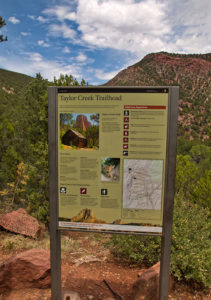 After a week in the scalding heat of Las Vegas, I was ready to slip into the wild for a little hike. I headed to Kolob Canyons on the north side of Zion National Park about mid-afternoon, looking forward to my very first hike in Utah. I was not disappointed.
After a week in the scalding heat of Las Vegas, I was ready to slip into the wild for a little hike. I headed to Kolob Canyons on the north side of Zion National Park about mid-afternoon, looking forward to my very first hike in Utah. I was not disappointed.
Talyor Creek Trail leads to the Double Arch Alcove, featuring a grotto of gigantic proportion. The sheer scale of everything in southern Utah was immense, including the idiots that I chatted with a couple of times on the trail.
To give you a relative sense of the scale of the Double Arch Alcove, look at these two photos. A few young dipshits were sitting with their dogs on the top of the first arch. The photo below was taken about a hundred meters away from the arch. I zoomed in on the group, confirming that I was seeing someone who thought bringing their dogs for a hike in a national park was a good idea.
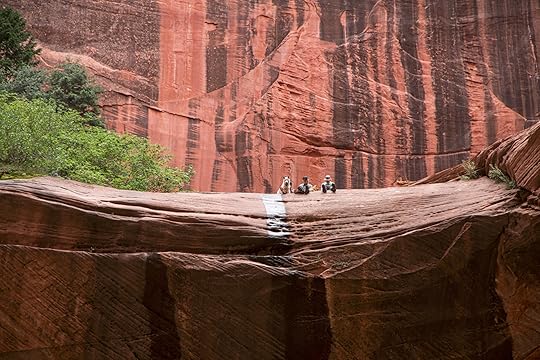
The photo below was shot from the same location, just zoomed out.
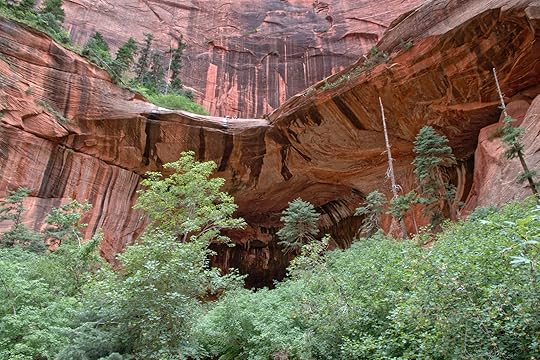
We’ll return to my discussions with these bumpkins shortly.
Taylor Creek Trail
The trail itself drops from the parking lot to meet up with the creek. For a couple of miles, the trail crosses back and forth across the little stream. As it was late summer, the water flow was just a trickle. My hiking boots would stay dry, but only for a day. The views of the cliff and rock formations became more and more dramatic.
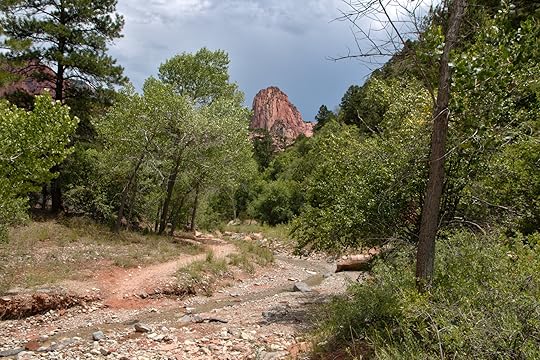
The further you walk, the more gigantic the rock formations seemed. They begin to box in the canyon, tighter and tighter, as you move closer to the Double Arch Alcove. However, until you are very close, the alcove remains hidden from view.
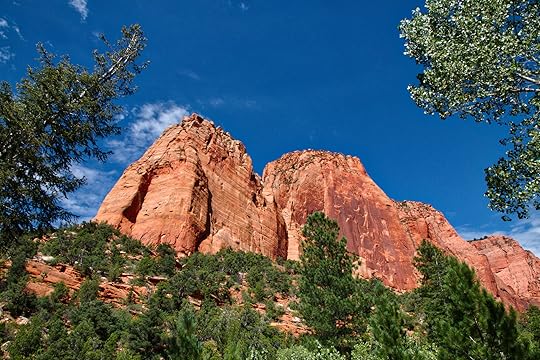
About two miles in, you come to Fife Cabin. Author Fife, an instructor at Southern Utah State College, built the cabin in 1930 as a haven to escape to and raise goats when school was not in session. This is the second cabin on the Taylor Creek Trail. Near the start of the trail, the Larson Cabin is easy to miss and not as picturesquely nestled in the woods like the Fife Cabin.
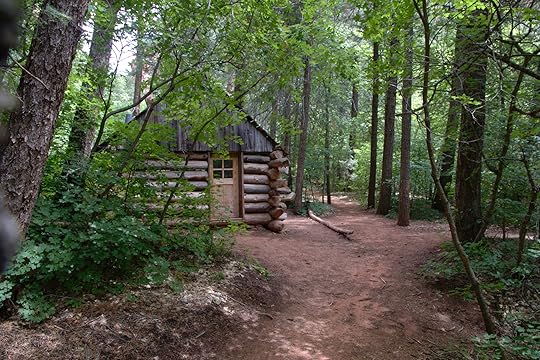
The trail then drops into the creek for about a half mile. I’m sure in the spring that you’d be splashing through the water, but in late July the creek bed is partially dry and easy to follow.
The Double Arch Alcove
Shortly after leaving the creek bed, the walls of the cliffs are closer together and rise precipitously into the sky. At first, you think that what you are seeing is just more of the wall of the cliff, but the closer that you get, the more the alcove comes into focus. I only expected to see a rock formation, but the top of the lower grotto is large enough for many trees to be growing.
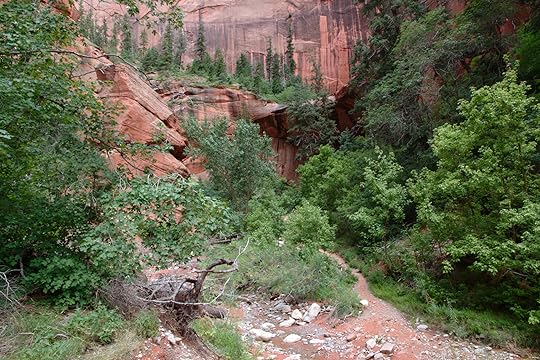
As you approach, the immense scale of the arches becomes more apparent. The second arch is far up the cliff wall.
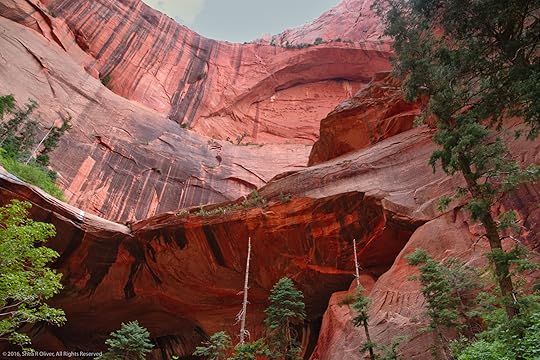
The grotto of the lower arch is absolutely huge. There were a couple of families there when I arrived, but they left within a few minutes, giving me some enjoyable time alone to snap some pictures. The semi-permeable rock seeps water that enables hanging gardens and moss to grow on the walls of cliffs.
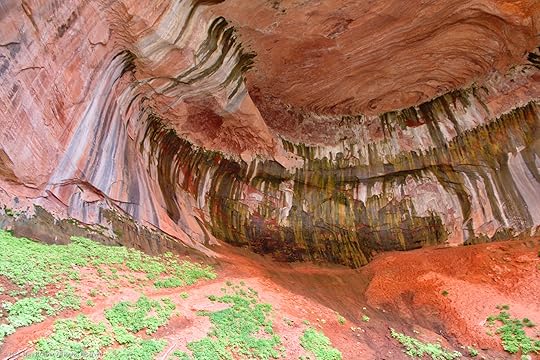
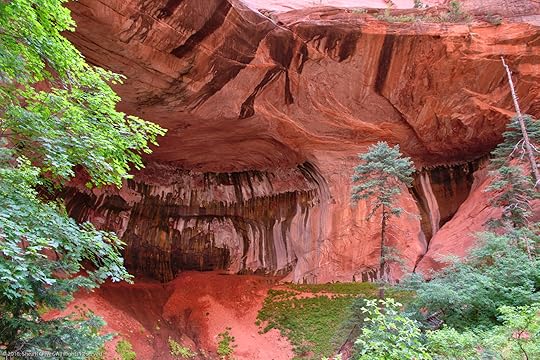
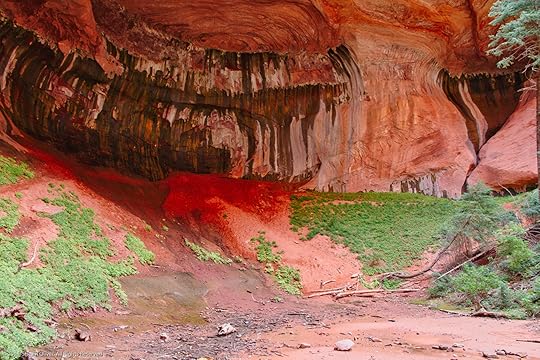
As my first stop in one of the Mighty Five® National Parks of Utah, I was truly awestruck by the fantastic beauty of the rock formations. As I turned away from the grotto and headed back toward the trailhead, a feeling of peacefulness spread through me. I felt very connected to the natural world, and my soul was at ease. I love being out on the trail. The sense of connection to our natural world always settles my spirit and makes life feel full of meaning.
Back to The Numskulls
As I was hiking out, a dog trotted up alongside me. Of course, it was from the group that was sitting on top of the lower arch. Within a few moments, the young men arrived, along with a second dog.
A younger me might have been quite direct and punitive to those who likely saw the NO DOGS signs, but disregarded the rules. However, I now take the approach encouraged by the National Park Service and attempt to educate folks about why dogs shouldn’t be in the parks. I explained how they could bother wildlife, leave diseases and parasites in their fecal material, or become a snack for a larger predator.
The boys listened and even apologized. Then they headed down the trail in front of me. Within about a half mile, I caught back up with them. Since they didn’t have leashes, one of the dogs had taken off, and they had to retrieve it. They looked at me sheepishly, as I had just chatted with them about the nuisance that their pets could be.
Now, none of these young men appeared to be future Rhodes Scholars but didn’t seem completely devoid of brains. However, when my peripheral vision saw what one of them was doing, my brain had one of those no-way-on-earth-are-you-actually-seeing-that moments. The guy was actually down on all fours, straddling the small creek, and lapping up water like a dog!
As is too often the case with park visitors, they had failed to bring any water. I proceeded explained to them the risks of giardia and cryptosporidium. However, I honestly doubt much of what explained stuck, but I’d done what I could.
For a good argument on why you should leave your dog at home, please read this article in High Country News by Marjorie “Slim” Woodruff.
Off To A Marvelous Start
Without a doubt, I was excited to begin wandering southern Utah. Starting off with such an enjoyable hike along a beautiful trail to an interesting destination, made me all the more excited for the coming days.
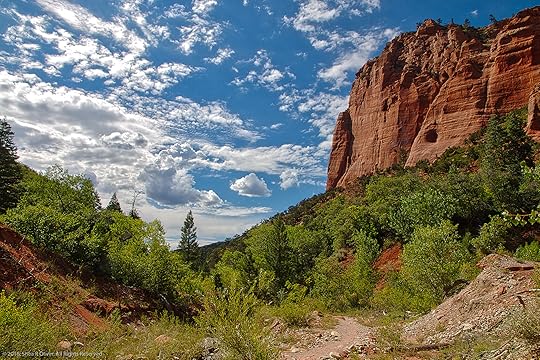
Additional Media
Please visit my Flickr Gallery for more picture of this wonderful hike:
20170730 Taylor Creek Trail, Zion National Park
Photo Bubbles
I love shooting 360º photo bubbles! These may or may not work depending on your device.
Google Streetview Double Arch Alcove, Lower Arch Grotto
BE A HERO & SHARE THIS PAGE
Share List
LEAVE A COMMENT
Please don’t be shy! Let me know what you think!
SUPPORT CRITICAL CONSERVATION EFFORTS
The post Hiking to The Double Arch Alcove in Zion National Park appeared first on Shea Oliver.








